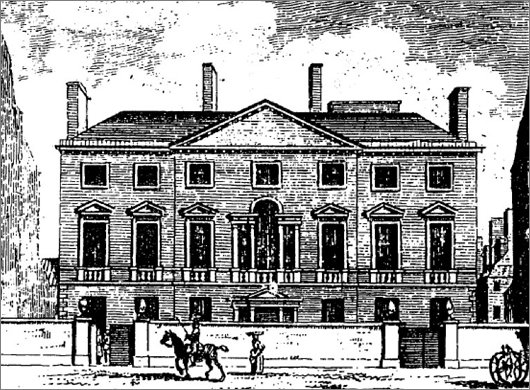Great Britain
About Andrew Cusack
 Writer, web designer, etc.; born in New York; educated in Argentina, Scotland, and South Africa; now based in London.
Writer, web designer, etc.; born in New York; educated in Argentina, Scotland, and South Africa; now based in London. read more
News
Blogs
Reviews & Periodicals
Arts & Design
World
France
Mitteleuropa
Knickerbockers
Argentina
The Levant
Africa
Cape of Good Hope
Netherlands
Scandinavia
Québec
India
Muscovy
Germany
Academica
A Bill Committee in the Commons
A Bill Committee meeting in one of the richly decorated committee rooms of the Palace of Westminster. The Minister is standing, rattling on in an explanatory defence of his government’s bill. Ostensibly these committees exist so that MPs can examine legislation in line-by-line detail and raise questions about whatever points or aspects they believe might cause problems if enacted.
“The question is that Clause 15 stands as part of the Bill.”
The Chairman, an MP of considerable experience, presides, assisted by a retinue of civil servants. He chews a pen and stokes his brow, frustrated by the boredom of the subject at hand. He is perhaps thinking of the weekend and the extreme unlikeliness that he will get down to the coast, and his sailboat, given the inclement weather.
A Scottish Member rises on a Point and the Minister yields the floor. Concerns are expressed about the precise meaning of Subclause 36 Paragraph C and insinuations made about potential costs. The Minister rises and suggests the Member’s criticism is excessively harsh. He then concedes he may have been imprecise in his explanation of the process involved in Subclause 36 Paragraph C.
The Doorkeeper, absurdly and arcanely attired in white tie, tails, and with the royal arms hanging from a gold chain round his neck, wears thick-rimmed glasses and leans back on a desk in a carefree fashion, blissfully paying little attention to the point the Hon. Gentleman has made in response to the proposed amendment.
“Just for the sake of clarity, we are not now talking about Amendment 13?”
“I have no intention of moving Amendment 13.”
“On a Point of Order then, Mr Chair, is it proper that the Member discuss Amendments 21 and 26 when he is not moving Amendment 13, which is the first Amendment to be considered?”
The Chairman corrects that it is perfectly alright for the Member to discuss whichever amendment he would like.
There are at least eleven civil servants in the room. One on the side hands a paper to another. He reads it and nods approvingly before passing it on to the civil servant next to the Chair. Another Member rises to discuss Amendment 54 Clause C.
“There’s an important role for an independent body to exercise scrutiny over this area and it would be wise for it to have a statutory basis.”
The entire proceedings are overshadowed by the continual sound of shuffling papers. One Member doodles on the day’s order-paper. A journalist leaves. The Member stops doodling and consults his iPhone. Then the Minister is grateful for that point. He is surprised but aware, since he was given this junior ministerial role, by the frequency with which this matter has arisen and has spoken before the relevant Select Committee.
Another Member’s face is illuminated by the glow of the iPad he is leaning over.
“Now before I become too Churchillian,” the Minister continues, “I think we’d better turn to the matter of the Amendments. Now the Honourable Member has, perhaps understandably, raised the point…”
A female Member smiles and shares a jest with one of her party colleagues. The Doorkeeper’s shift ends and he is replaced by one of his bearded confrères. The civil servant beside the Chairman folds a paper and stares unthinkingly into the distance.
“In respect for the Hon. Gentleman’s desire for continuing debate and discussion with the relevant authorities…”
“He hasn’t addressed my point about Subsection 2!”
The portly Doorkeeper moves with surprising adroitness in delivering a note from a Member to a civil servant across the room. The Minister’s PPS hands him a relevant paper. The Chairman smiles in response to one of the Minister’s light-hearted remarks.
“I’m sure the Minister will agree that this is not the beginning of the end but merely the end of the beginning.”
“If only!” a Member interjects.
It is 3:32pm. The MPs will be here for hours yet.
Don Bosco in London
Just went to venerate the relics of Don Bosco, which are doing a UK-wide tour organised by the Salesian order. There was quite a crowd waiting for the Saint’s earthly remains to be unveiled at 2 o’clock — suprising for early afternoon on a workday. Before the relics were even made viewable there were pilgrims huddled around the veiled reliquary, whom the organisers eventually had to shoo away in order to organise some proper veneration.
The faithful are able to venerate the relics at Westminster Cathedral from 2:00pm to 8:30pm today and tomorrow only, after which they will spend the next two days at St. George’s Cathedral in Southwark before returning to Italy.
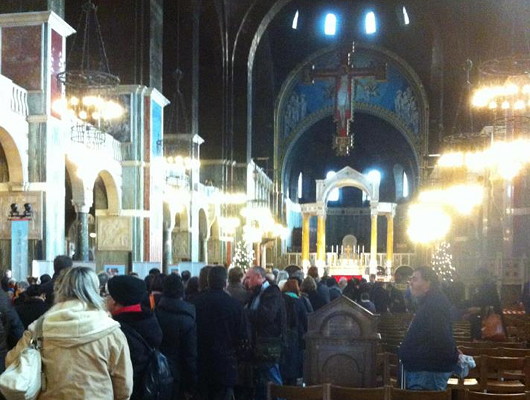
Fit for a Duke in Covent Garden
Russell House, No. 43, King Street
This apartment occupies the piano nobile of a 1716 house designed by Thomas Archer for the Earl of Orford, then First Lord of the Admiralty. He obtained the lease for the site from his uncle, the Duke of Bedford, on condition he tear down the house located there and build a new one. Batty Langley, the eighteenth-century garden designer and prolific commentator hated it, and devoted over 200 words of his Grub Street Journal (26 September 1734) to slagging it off. The Grade II*-listed building looks onto Covent Garden Piazza and has seen a number of uses over the years. (more…)
London’s Fallen Water
A cursory investigation into the metropolis’s drinking water yields results that veer towards the somewhat disturbing
by ALEXANDER SHAW in London
UNDERSTANDING  enables self-preservation, but occasionally leads us out of Eden too. Thus, I’m not encouraging you to understand how London’s water is recycled, I’m merely tempting you to.
enables self-preservation, but occasionally leads us out of Eden too. Thus, I’m not encouraging you to understand how London’s water is recycled, I’m merely tempting you to.
Education is like lighting a fire, not filling a bucket. One realisation leads to another:
Q: What happens when the ice cubes melt in a brimming Tumbler of Scotch?
A: Nothing – so the disappearance of the polar icecap won’t raise sea levels. So I can drive an eight-litre Bentley after all.
Q: What happens when two cars each travelling at 30mph collide head on head?
A: The Bentley’s CD player skips a track and someone spends the afternoon picking a Nissan Micra out of the radiator.
Point by point, basic wisdom allows us to unpick the paranoid egalitarian ideas subversively presented by the Marxist GCSE Physics curriculum.
However, I am horrified that, even with my impeccable logic, it has taken me three years to realise that London’s recycled potable water supply harbours a rather dirty secret. It was the lime scale in the kettle which gave it away. We all know that, as with many cities, London recycles its water. But why, after the process of evaporation and recondensation, does limescale remain in the supply? The answer, to my unutterable horror, is that it is not recycled by evaporation.
I’ve given up trying to get straight answers from Thames Water about exactly what goes on. Like the pro-choice lobby and socialist economists, they gloss over all manner of sins with a vast lexicon of euphemisms.
For ‘carbonaceous waste,’ read: diarrhoearic faeces comprised of doner kebabs and salted French fries, crammed past cankerous lips by nail-bitten greasy fingers of obese female students in bus stops at 3am. For ‘nitrogenous waste,’ read: cheap lager, churned through proletarian digestive systems whose uncircumcised owners moan with relief as the steel urinal tangs of ammonia – gobs of chewing gum and Mayfair fag butts collecting at the foot of the drain. After a brief sifting and filtering, these ‘wastes’ then gush out of London showerheads. The final confluence of the city’s vomit is on my own pale, patrician flesh.
It might not disturb me so much if the water were sent back to the same house, or even the same postcode. At least in Chelsea, we would be drinking the urbane fruits of some anorexic supermodel’s colonic. But no, the city’s water is pooled in something called the ‘Thames Water Ring Main,’ which sounds ghastly, and is so huge that it reaches down to somewhere called ‘zone four.’
I have read an account of the process used to purify our sewage on Thames Water’s website. First they filter it ‘through a rake’ (right, OK), and then ‘most of the solids are removed by settlement.’ After that, they skim off the cleaner bit of what, by then, is basically an un-shaken-up shit smoothie and pump it through a gravel pit of bacteria. Then they send it back to my house.
The internet consensus seems to be that, on average, our tap water has gone round this system approximately seven times and, for those who still have diehard faith in the system, people start to feel nauseous when they drink 11th generation water. So yes, it does get muckier each time.
“Well, if we don’t get ill it must be alright,” a friend of mine concluded, taking a defiant swig of the tap water she’d just ordered in a café. It seems this may also be the underlying philosophy of Thames Water. I find it an unsettlingly laissez faire approach.
The U.S Geological Survey discovered that the dozens of trace chemicals – often derived from medication – which slip through modern filtration processes amount to ‘only a thimble full in an Olympic pool.’
Only!?! If that thimble were of blood, a shark would smell it. If it were Polonium 210, it would be enough to wipe out the entire city. And, heavens above, any folk who take homeopathy seriously will consider that sort of dilution the medical equivalent to downing a pint of dysentery or bathing in the cesspit of a Kinshasa prison.
Furthermore, the ‘fresh’ water that is brought in to our supply from the Thames contains the only-slightly-treated sewage of the settlements upstream. I’m going to guess that 95% of the female populations of Reading, Cowley, Slough and Swindon perform some type of medical injunction upon their reproductive system every Saturday (or Sunday morning, God forbid). And, of course, what goes in must come out.
A Drinking Water Inspectorate report submitted to Defra in 2007 proclaims that our UK filtration techniques ‘can result in removal rates of more than 90% for a wide variety of pharmaceuticals.’ Oh, good! Only less than 10% gets back in! Further down the report, we read: ‘Very limited data were available for the concentrations of pharmaceuticals or illegal drugs in UK drinking waters, but data from the rest of Europe and the USA have shown that concentrations in finished drinking water at treatment works are generally =100 ng.l-1’ (which sounds like another euphemism to me). The report continues to say that the filtration processes are ‘not specifically designed to remove pharmaceuticals and several compounds have been reported in finished drinking water.’
The report is available in summary here. I was retching and gagging by the third paragraph.
It comes as little surprise to me that our perverse society seems more preoccupied with the treatment of the ‘sludge’ which is siphoned out, than the ‘water’ which is pumped back in to our taps. The Thames Water reports abound with the ‘European Sludge Directive,’ the worthy ‘good chemical status,’ and not forgetting, of course, the all-important ‘Safe Sludge Matrix.’ I have already expounded upon the true meaning of ‘carbonaceous’ and ‘nitrogenous,’ so I will spare you my reflections on ‘sludge.’
In order for my water to be clean, it must be broken down to a molecular level, de-ionised, re-ionised, blessed by a bishop, and prayed over by a virgin.
However, I have identified two brands of bottled water which almost meet the standards which we must now demanded from natural sources: Tasmanian Rain ($11 a bottle), is captured from the ‘purest skies on earth,’ and doesn’t touch the ground before it gets to the bottle. Only problem is: what if a bunch of Aussies on stag-night fly a smoky old Cessna over the rain catchment facility? Perhaps better is 10 Thousand BC ($14 a bottle) – or the hippy’s dilemma, as I call it – because it’s extracted from a glacier and derives its purity from having been frozen since before the fall of man.
Or, of course, you could just give up drinking water, as I did years ago.
Marlow’s St Paul’s Capriccio
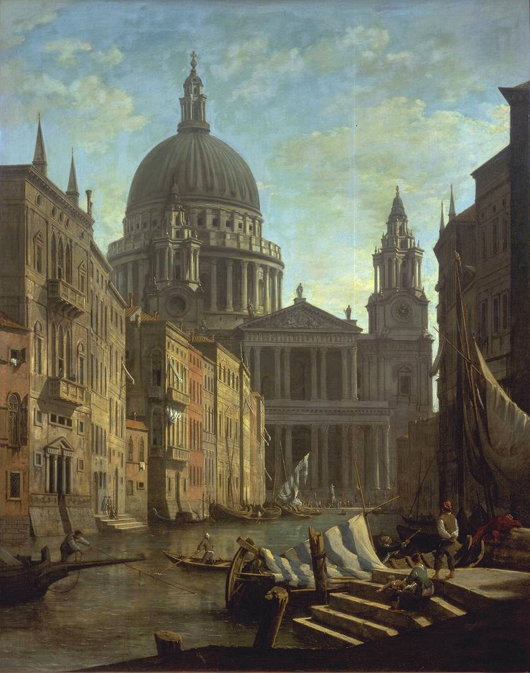
c. 1795; oil on canvas, 60 x 41 in.; London, Tate Gallery
The view of St Paul’s Cathedral as if it had been completed according to the original plans of Wren and with Hawksmoor’s baptistry (which I posted yesterday) reminded me of this capriccio by William Marlow. And then this in turn recalled my 2005 post If London Were Like Venice.
Little Ben
 WALKING THROUGH Victoria recently, I was horrified to see the recent renovations and street improvements have led to the disappearance of ‘Little Ben’, the small Victorian clocktower that sat in a traffic island halfway between Westminster Cathedral and Victoria Station. Little Ben is a convenient meeting place in a district that is rather uninspiring and surprisingly lacking in conveniences.
WALKING THROUGH Victoria recently, I was horrified to see the recent renovations and street improvements have led to the disappearance of ‘Little Ben’, the small Victorian clocktower that sat in a traffic island halfway between Westminster Cathedral and Victoria Station. Little Ben is a convenient meeting place in a district that is rather uninspiring and surprisingly lacking in conveniences.
Why, for example, is there no decent pub in Victoria? If you need a meal, Grumbles of Pimlico is walking distance, and they treat you well at Il Posto. But a decent pub atmosphere is not to be had, unless you fancy The Pub Formerly Known as the Cardinal (now styling itself as ‘The Windsor Castle’).
Happily, a simple Google search reveals that Little Ben’s absence is merely temporary: indeed, Little Ben is taking a rest-cure. The goodly folk at Wessex Archaeology have informed us as such.
The clock owes its creation to Gillet & Johnston of Croydon, who built Little Ben in 1892 and erected it in the middle of Victoria Street. It fell victim to a road-widening scheme and was removed in 1964 but, after sitting in storage unappreciated for some years, it was finally renovated and restored to its original location in 1981.
Transport for London is currently working on a significant upgrade to Victoria Underground Station, including a rearranged traffic alignment on surface level, in addition to new entrances and exits and a great big whopping ticket hall sous la terre. When all is finished and done and in tip-top shape, Little Ben will be returned to his traditional location, and some semblance of order will return to this sector of the most unglamorous Victoria Street.
Tretheague
Stithians, Cornwall
It having just been St Pirran’s Day recently, why not have a look at some Cornish property up for grabs? Just southwest of the Cornish village of Stithians is this curious little house named Tretheague, now up for sale from Savills with seventeen acres attached. Stithians is known for its agricultural show held every July since 1834 and “one of the largest and best-known ‘one-day’ shows in the West Country” according to the agents’ propaganda tells us.
“The Manor of Tretheague” the propaganda continues, “was owned by the ancient Cornish Beville family until the end of the 16th century. Philip Beville of Killygarth died leaving the property to his son in law, Sir Bernard Grenville of Stowe, who sold off various tenements and dismembered the manor as such. The family of Tretheague lived at the property for three centuries until Walter Tretheague died around 1602. They were followed by the Morton Family who did well from mining interests in the county until another wealthy tin adventurer, Nicholas Pearce, who developed Wheal Maudlin at Ponsanooth, took over the old manor in 1690.”
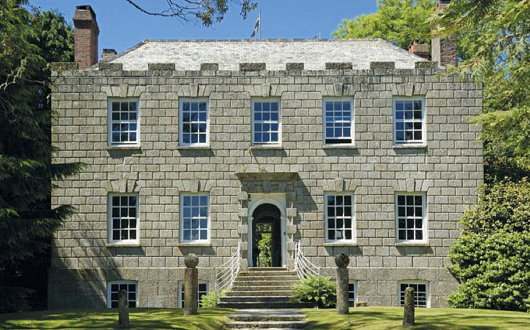
“John Pearce rebuilt the house the year before becoming High Sheriff of Cornwall in 1745 and his descendants sold the property to J M Williams in 1872, another member of a famous Cornish family that prospered from the Cornish mining boom. Under the guise of Williams Cornish Estate the property was sold privately to Bernard Penrose in 1962 who then spent almost 20 years restoring this somewhat unique and unspoilt gem that had remained almost unaltered since the time of its construction.”
“The house standing replaced an Elizabethan house that was recorded as having seven chimneys in the tax of 1660, although only small fragments of mullions and cut and chamfered stone survive. The major rebuild took place around 1744, almost certainly designed and overseen by the famous Greenwich architect Thomas Edwards who presided over several commissions in Cornwall for a period when rich County families and well-to- do mining adventurers felt it necessary to show off their new found wealth and elevation in Cornish society.”
“The house overlooks beautiful parkland which borders the drive and separates the house from the country lane. This parkland has been the scene of summer cricket matches from time to time and now contains individual specimen trees of lime, Canadian maple, beech and horse chestnut.”
“An imposing set of granite steps with wrought iron railings rise to the entrance which is at upper ground floor level. Inside the house much of the original period detail is intact, and on the upper ground floor the hall, panelled dining room and magnificent shallow-rise turning staircase feature fine plaster ceilings with modillions and Rococo detail.”
I like the exterior and setting, but from the photos the house feels curiously small on the inside. I somewhat dislike such primly contained box plans, and prefer a bit of awkward additions and extensions from centuries of use. Treatheague seems a bit too clean cut, but worth a look at least.
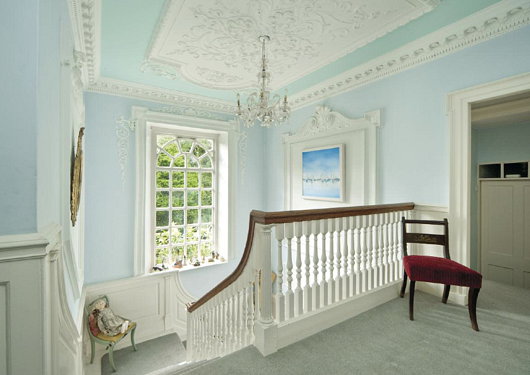
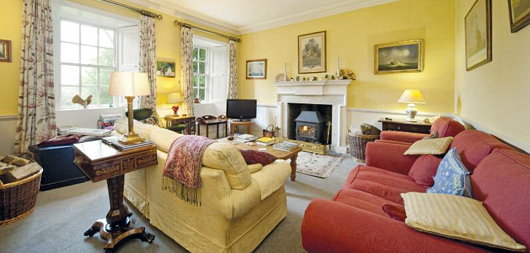
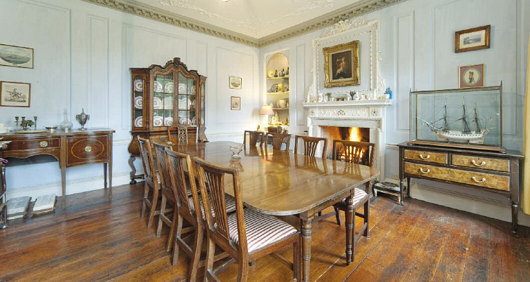
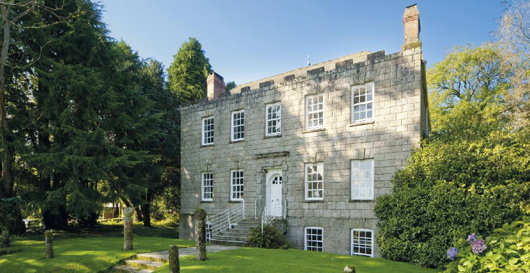
Admiralty Arch for Sale
Sort of: Queen Offers Long Leasehold of Edwardian London Landmark
SIR ASTON WEBB’S great Edwardian Baroque office-building-cum-triumphal-gateway, Admiralty Arch, will be offered up for a long leasehold by HM Government. The Grade-I listed building, constructed between 1910 and 1912, is one of the best-known in London for finishing the long view down the Mall from Buckingham Palace and connecting it to Trafalgar Square beyond. Admiralty Arch features 147,300 square feet across basement, lower ground, ground, and five upper floors.
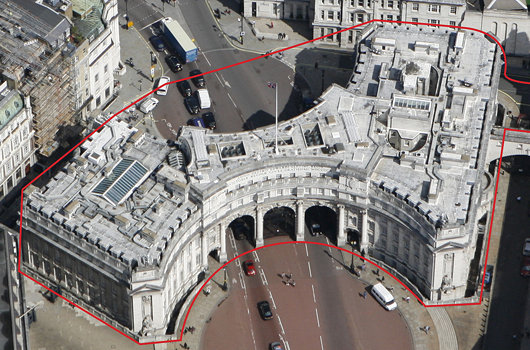
Savills have been appointed as the sole exclusive agent to seek interest in the long leasehold. “The Government’s objective is to maximise the overall value to the Exchequer from the re-use of Admiralty Arch,” the Savills press release noted, “and to balance this with the need to respect and protect the heritage of the building, now and in the future, enable the potential for public access and ensure awareness of, and be prepared to respond to, potential security implications.”
Our prediction: oil money from abroad will turn it into a hotel. Boring, I know!
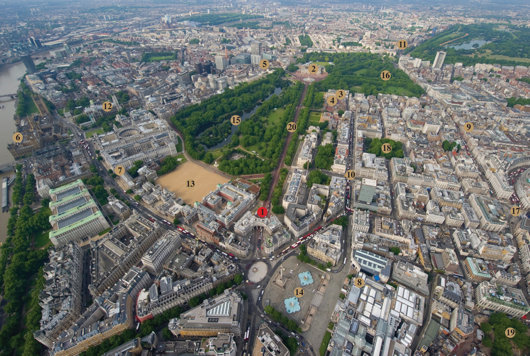
Comper in Clerkenwell
The unbuilt Church of St John of Jerusalem
IN THE REALMS of architecture, the unexecuted project has a certain air of fantasy to it — the allure of what might have been. Ranking high amongst my favourite unbuilt proposals is Sir Ninian Comper’s project for the Church of St John of Jerusalem at Clerkenwell. Comper designed the scheme in the middle of the Second World War as a conventual church for the Venerable Order of St John, the Victorian Protestant revival of the old Order of St John (now more commonly known as the Order of Malta) which was banished from England at the Reformation. The design (below) is a Romanesque-Gothic hybrid, a splendidly exuberant cross-fertilisation of two styles more frequently opposed to one another in the minds of most.
One of the proposals for the serious reform of the Order of Malta in Britain is for the Grand Priory of England to divest itself of its interest in the Hospital of St John & St Elizabeth and its associated chapel in St Johns Wood. Owing to a complicated series of events, conventual events are taking place at the Church of St James, Spanish Place already. As the Venerable Order never executed Comper’s brilliant design, perhaps the Order of Malta might consider buying a suitable site in London and making Comper’s fantasy a reality.
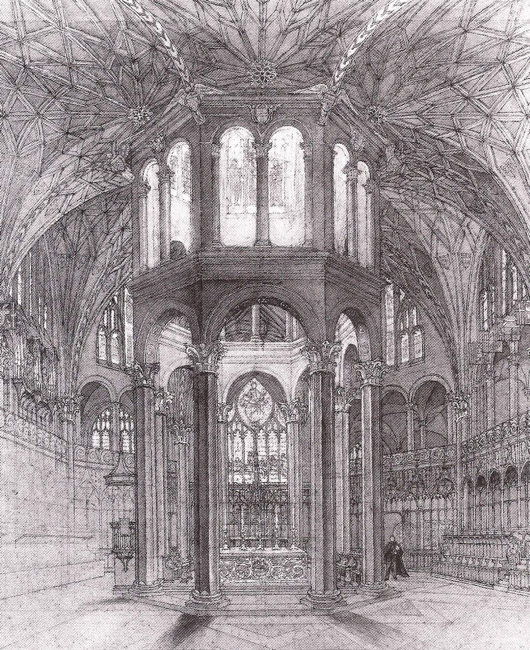
Cardinal Manning
Over at Reluctant Sinner, Dylan Parry has an excellent post on Cardinal Manning, the second man to serve as Archbishop of Westminster. Manning is all too often forgotten, despite being one of the most widely loved and respected men of his generation. His funeral, famously, was the largest ever known in the Victorian era. Besides his wisdom at the helm of England’s most prominent see, the good cardinal’s greatest legacy might be his influence on Rerum Novarum, the great social encyclical of Leo XIII. Dylan is planning on writing further on the subject of Cardinal Manning, giving us something to look forward to. (more…)
St Andrew’s & Blackfriars Hall, Norwich
NORWICH, THAT CITY of two cathedrals, is known for Colman’s Mustard and the television cook Delia Smith (herself Catholic). Unknown to me until recently is that the capital of one of England’s greatest counties is also home to the most complete Dominican friary complex in all of England. The Dominicans had arrived in Norwich in 1226 — the swiftness with which they reached the city comparative to the foundation of the Order of Preachers is indicative of England’s inherent inclusion in the Catholic Europe of the day.
From 1307, the OPs occupied this particular site in Norwich until the Henrician Revolt, when the friary was dissolved and the city’s council purchased the church to use as a hall for civic functions. The nave became the New Hall (later St Andrew’s Hall) while the chancel was separated and used as the chapel for the city council and later as a place of worship for Norwich’s Dutch merchants. (The last Dutch service was held in 1929).
The complex has been put to a wide variety of uses. Guilds met here, as did the assize courts. It was used as a corn exchange and granary. King Edward VI’s Grammar School began here. Presbyterian and Baptist non-conformists worshipped in various parts during the late seventeenth century. William III had half-crowns, shillings, and sixpences minted here. In 1712, the buildings became the city workhouse until 1859, when a trades school was established the continues today elsewhere as the City of Norwich School. The East and West Ranges are now part of the Norfolk Institute of Art and Design. (more…)
Burn Baby Burn!
A Burning-in-Effigy at Exposes the Cowardices of Tomorrow’s Politicians
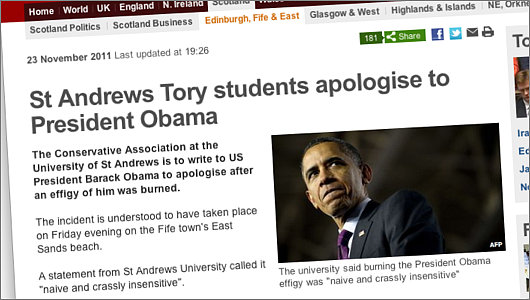
I cannot condemn this in more stringent terms. The Tories at the University of St Andrews have apparently burnt Barack Obama in effigy and then backtracked with all manner of pussyfooting around and the standard issue of apologies. Burning in effigy is a perfectly legitimate form of political expression and has been verified by centuries of tradition.
What’s more, I suspect there’s a bit of the old racism behind the apologies: would anyone have bat an eyelid if Mr Obama’s predecessor had been burnt in effigy by students? I, for one, would have happily joined in both effigy-burnings. The more effigies burnt the merrier. Chesterton remarked “It is terrible to contemplate how few politicians are hanged”, and I would suggest effigy-burning is a potentially more wholesome if less efficacious alternative.
If you’re going to burn an effigy, burn an effigy and then stick with it. But the weak-kneed, shilly-shally Tories always want to engage in a bit of old-school fun before hoisting up the white flag and issue an “unreserved public apology”. Rank hypocrisy of the highest order! Ye cannae have yer cake an’ eat it, too!
Begley Takes to the Skies
Brave Bear Skydives in Support of Hammersmith’s Irish Cultural Centre
The Irish Cultural Centre in Hammersmith, London is in danger of closing as its landlord, the local council, is putting the ICC’s building up for sale. The enterprising folk at the Centre have launched the Wear Your Heart for Irish Arts campaign to raise the funds required to save this outpost of Gaelry and have adopted Begley the Bear as the campaign mascot. Begley is a brave little lad and he recently undertook a charity skydive to raise money for the Centre.

Alright, he wasn’t so brave at first, but he worked up the courage in time.

The ICC’s assistant manager, Kelly O’Connor, accompanied Begley on his endeavour.


She had to cover poor Begley’s eyes at the start…

…but then they got into the swing of things.

And at the end of the day, who could say no to a pint of plain?
The Old In & Out
Cambridge House, Number Ninety-four, Piccadilly
ON MY WAY TO the Cavalry & Guards Club yesterday for lunch with an ancient veteran of King’s African Rifles (“Hardly qualify for this place — Black infantry!”) I realised I was a bit ahead of schedule and so took a gander at Cambridge House, the former home of the Naval & Military Club on Piccadilly. It’s surprising that an eighteenth-century grand townhouse of this kind has sat in the middle of the capital completely neglected, unused, and falling apart for over a decade.
Edinburgh Update
Well, I was going to direct you over to Seraphic’s blog for an at least partial account of my Edinburgh weekend but she’s done gone and taken the dagnabbed thing down. It’s just as well, as when she described the assembled guests at a long Sunday lunch by the sea in Portobello she finished her description with “and Andrew Cusack wearing something rumpled from Ralph Lauren”. In fact, it was Massimo Dutti, but there you have it. (more…)
Fra Freddy, Rest In Peace
Yesterday, I was very saddened to hear of Fra Freddy’s death. Fra Freddy was a legendary character whom I was introduced to in my first year at St Andrews. He was invited to speak to the Catholic students most years on some subject or another — an introduction to prayer or a lenten meditation. I was quite pleased when he was so taken with a poster I designed to advertise one of his talks that on his way back to Edinburgh he nipped out of the car at the last minute and grabbed a large copy. Fra Freddy was an old-fashioned stick-in-the-mud with a good sense of humour, but he also had the capability to surprise with a kind word when you least expected it.
Fra Fredrik John Patrick Crichton-Stuart was born September 6, 1940 to Lord Rhidian Crichton-Stuart (son of the 4th Marquess of Bute) and his wife Selina van Wijk (daughter of the Ambassador of the Queen of the Netherlands to the French Republic). He was raised in Scotland and North Africa (where his father was British Delegate to the International Legislative Assembly of Tangier) and was educated first at Carlekemp in North Berwick and then at Ampleforth. He joined the Order of Malta in 1962, later being named the Delegate for Scotland & the Northern Marches. In 1993 he was appointed Chancellor of the resurrected Grand Priory of England. Fra Freddy became Grand Prior himself when his cousin, Fra Andrew Bertie, died in 2008 and was succeeded by the then-Grand Prior of England, Fra Matthew Festing.
Fra Freddy was a devoted follower and promoter of the traditional form of the Roman rite. He joined Una Voce Scotland in 1996 and became secretary in 2000. Two years later he was named councillor and senior vice-president of FIUV, the International Federation ‘Una Voce’, and briefly served as its president in 2005.
Over the past year or so Fra Freddy had been varying ill but seemed to recover. I am told he was found dead yesterday morning, still clasping his breviary. He was well-known in Edinburgh and beyond, and he will be missed by his many friends as well as those who worked and volunteered with him or interacted with him in his charitable activities.

FREDERICK JOHN PATRICK CRICHTON-STUART
Grand Prior of England
of the
Sovereign Military & Hospitaller Order of St John
of Jerusalem of Rhodes and of Malta
6 September 1940 – 14 June 2011
Eternal rest grant unto him, O Lord,
and let perpetual light shine upon him.
May he rest in peace.
Amen.
The Commons in the Lords
IT WAS THE NIGHT of 10 May 1941. For nine solid months the Luftwaffe had thrown everything it had at the people of London, as Hitler hoped to bomb the English into despair and surrender. By early May, the Nazis realised the campaign had failed, and resources had to be directed elsewhere. The Blitz had to end, but on its final night, it hit one of its most precious targets. Twelve German bombs hit the Palace of Westminster that night, with an incendiary striking a direct hit at the House of Commons. The locus of Britain’s parliamentary democracy was consumed by flame and completely destroyed. (more…)
A Pell Sighting
…and sundry other occurences
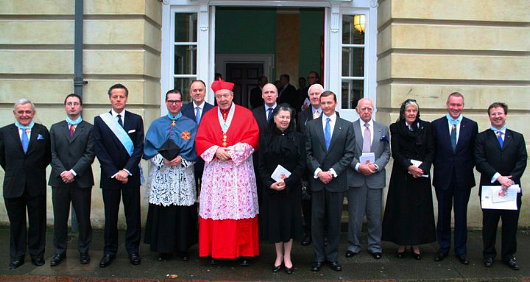
Outside of Rome, you don’t run into cardinals all that often, but last Saturday I caught sight of one of the most popular clerics in the Catholic Church: Australia’s Cardinal Pell. The occasion was the Cardinal’s reception into the Sacred Military Constantinian Order of St George, which took place in the Little Oratory. His Royal Highness the Duke of Noto presided over the investiture, and if you squint your eyes enough you can make out a profile shot of Young Cusack in the background of the photo of the Duke (below). In addition to the Cardinal Archbishop of Sydney’s being made a Bailiff Grand Cross of Justice, six others were invested as members of the Constantinian Order, including His Excellency Don Antonio da Silva Coelho, the Ambassador of the Order of Malta to the Republic of Peru. For more info, see the Order’s notice on the event. (more…)
The South Kensington Museum
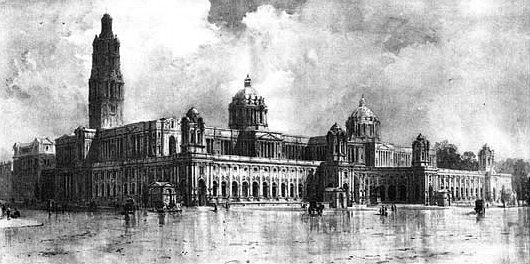
ANOTHER unbuilt project: this time a plan for completing the South Kensington Museum (or the Victoria & Albert as it’s now called) in the part of London which has become known as ‘Albertopolis’. The museum grew incrementally from its first foundation as the Museum of Manufactures after Prince Albert’s Great Exhibition of 1851. 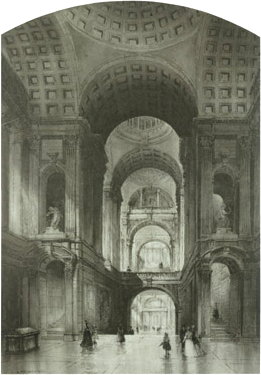 The first design for the museum at its current site was by Gottfried Semper, but the plan was rejected as being too expensive. And so over the years the facilities grew incrementally and according to to haphazard plans. In the 1890s, eight architects were invited to submit proposals for a grand scheme completing the site under a unified architectural plan.
The first design for the museum at its current site was by Gottfried Semper, but the plan was rejected as being too expensive. And so over the years the facilities grew incrementally and according to to haphazard plans. In the 1890s, eight architects were invited to submit proposals for a grand scheme completing the site under a unified architectural plan.
The judges cited this plan, by John Belcher, as the most original of the eight submissions. It’s a splendid composition in high Edwardian neo-baroque. The duality of the main domes is a particular confident touch, and harks back to Greenwich. Belcher’s baroque conception was not just an external factor: his interiors featured vast, sweeping spaces that would have been impressively monumental and reflecting the power and influence of the British Empire at its presumed cultural zenith.
“Although unsuccesful in the competition,” writes Iain Boyd Whyte of Edinburgh University, “this project attracted considerable praise in the professional journals for the plasticity of the main street facade and for its grand, Michelangelesque domes.” While the judges appreciated Belcher’s design, they worried about the cost of its execution, and awarded first prize to Aston Webb instead. His scheme was inaugurated in 1899 by the Queen-Empress, who renamed the institution ‘the Victoria & Albert Museum’ simultaneously.
I wonder if Belcher’s design would have gone better with the neighbouring Brompton Oratory, or if the Oratory benefits from having the V&A in a differing, brick-based style.

Diary
HOW MANY COUNTRIES have you been to? As for myself, not many, perhaps a dozen, although I’ll concede that that dozen is spread over four continents. I know people who have been to two or three times as many countries as I have, particularly if they’ve travelled through the Continent, where you can notch up several in a single day. My travel plans tend to be those of saturation rather than spread: I visit places and start relationships with them and then keep coming back.
And how do you decide that you’ve “been” to a country? There are various methods of determination. (more…)
Search
Instagram: @andcusack
Click here for my Instagram photos.Most Recent Posts
- Faithful Shepherd of the Falklands April 8, 2025
- Articles of Note: 8 April 2025 April 8, 2025
- Proportionality Destroys Representation April 8, 2025
- Sag Harbor Cinema March 26, 2025
- Teutonic Takeover March 10, 2025
Most Recent Comments
Book Wishlist
Monthly Archives
Categories

